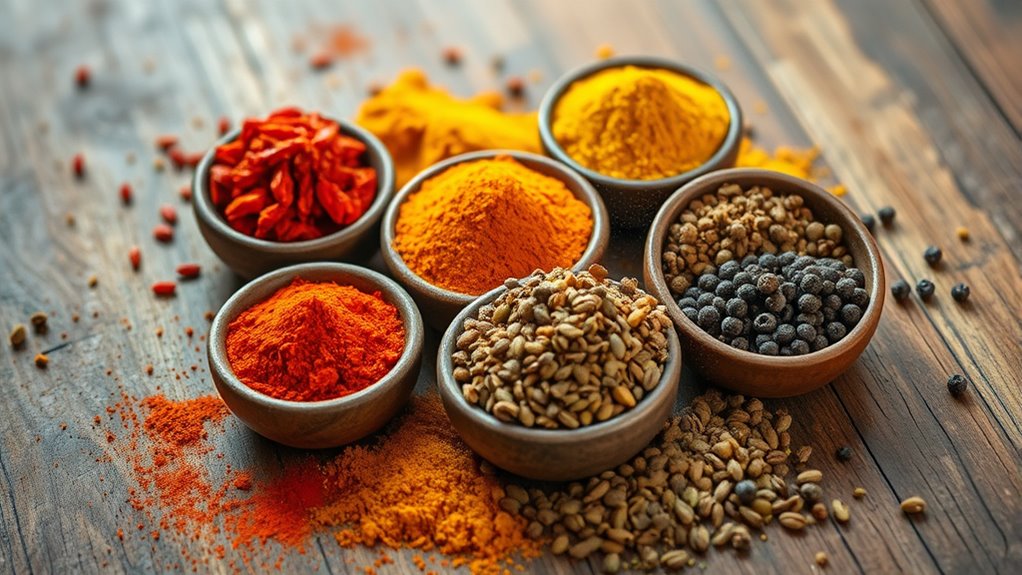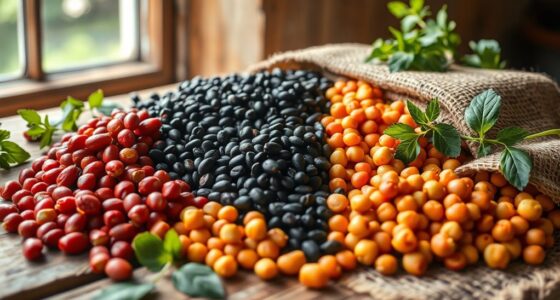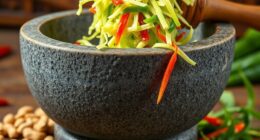Garam masala’s rich flavor comes from its key spices, each with unique benefits. Cinnamon adds warmth and sweetness, while cumin and coriander bring earthy and citrus notes. Cardamom and cloves give a spicy, floral aroma, and nutmeg and mace add depth with warm, nutty flavors. Regional variations influence their proportions and preparation, often involving toasting and grinding. To uncover how these spices come together and their cultural origins, keep exploring further.
Key Takeaways
- Garam masala is a traditional Indian spice blend with regional variations based on local ingredients and culinary traditions.
- Core spices include cinnamon, cumin, coriander, cardamom, cloves, and nutmeg, each contributing distinct flavors and health benefits.
- The aromatic profile combines sweet, spicy, and warm notes, enhancing both savory and sweet dishes.
- Preparation involves dry toasting spices to release essential oils, then grinding into a fine powder for optimal flavor.
- Regional differences influence ingredient proportions and methods, shaping the unique character of each garam masala blend.
The Origins of Garam Masala: Historical and Cultural Background
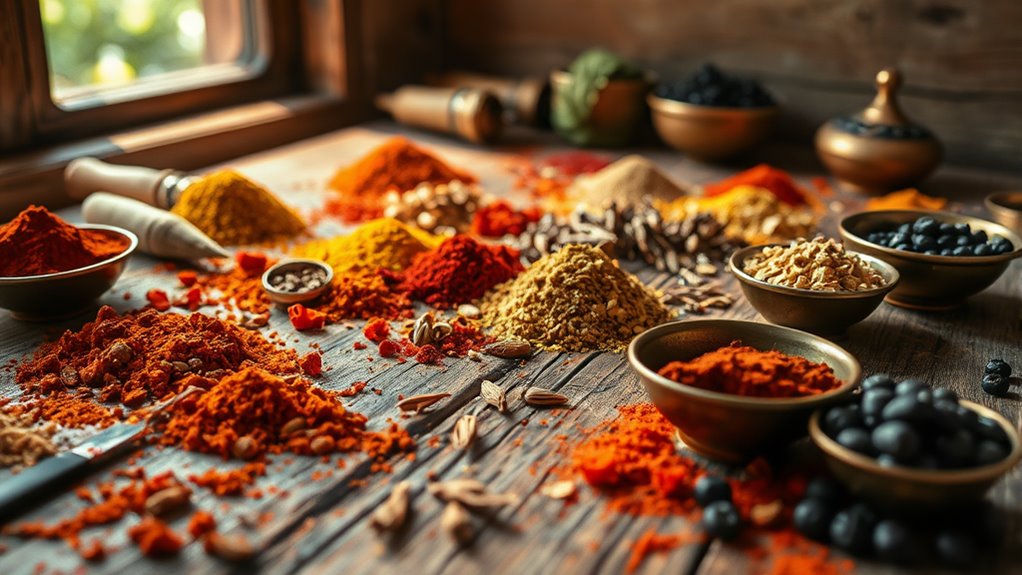
Garam masala has deep roots in Indian history and culture, evolving over centuries as a key spice blend in traditional cooking. You might not realize it, but its origins date back to ancient India, where spice trade thrived. Early traders exchanged spices like black pepper, cardamom, and cloves, laying the groundwork for blends like garam masala. Over time, regional variations emerged, reflecting local ingredients and tastes. It became integral to religious rituals, festivals, and daily meals, symbolizing warmth and hospitality. The name itself, meaning “hot spice mix,” highlights its role in warming the body and soul. Trade routes played a significant role in spreading these flavors across regions and cultures. As centuries passed, colonial influences and globalization introduced new spices, but garam masala remained a staple, embodying India’s rich culinary legacy.
The Role of Cinnamon in Garam Masala
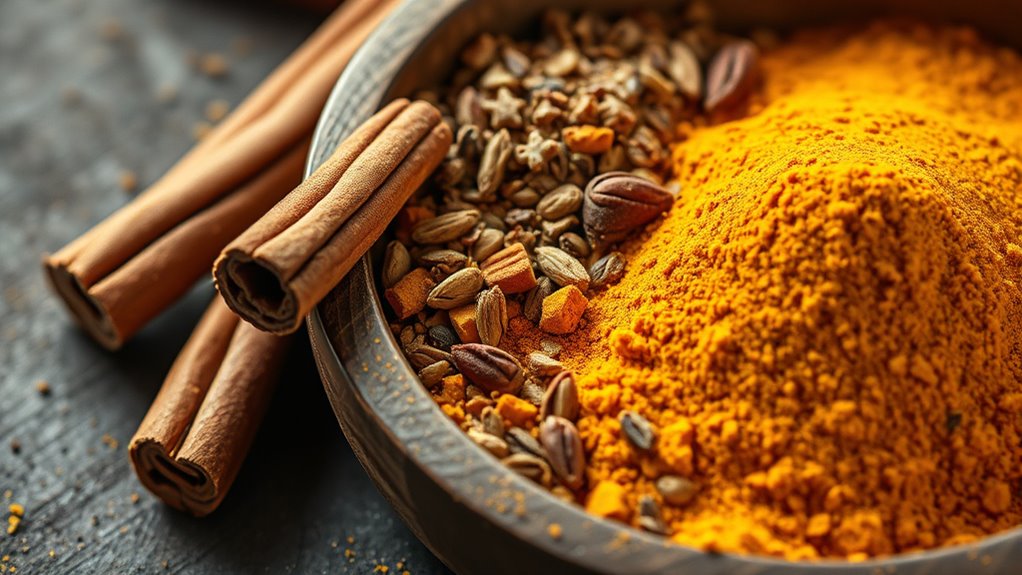
Among the many spices that define garam masala, cinnamon stands out for its warm, sweet aroma and distinct flavor. It adds a comforting depth to the blend, balancing the heat of other spices with its subtle sweetness. When you include cinnamon, you introduce a layered warmth that enhances the dish’s richness. Its aromatic oils release slowly, filling your senses with a fragrant, spicy-sweet scent. Cinnamon also acts as a flavor enhancer, bringing harmony to the complex mix of spices. You’ll notice how it elevates the overall profile, making dishes more inviting and aromatic. Its versatility means it pairs well with other ingredients, creating a well-rounded and balanced spice blend. Additionally, cinnamon’s presence in natural origin highlights its natural origin and aromatic properties. The use of cinnamon in spice blends like garam masala is rooted in its aromatic qualities, which contribute significantly to its popularity. Cinnamon’s role is essential, providing warmth and depth to your garam masala. Including cinnamon can also support health benefits, adding to its appeal in both culinary and traditional medicinal uses. Moreover, understanding the spice components helps appreciate its importance in traditional recipes.
The Significance of Cumin Seeds and Coriander
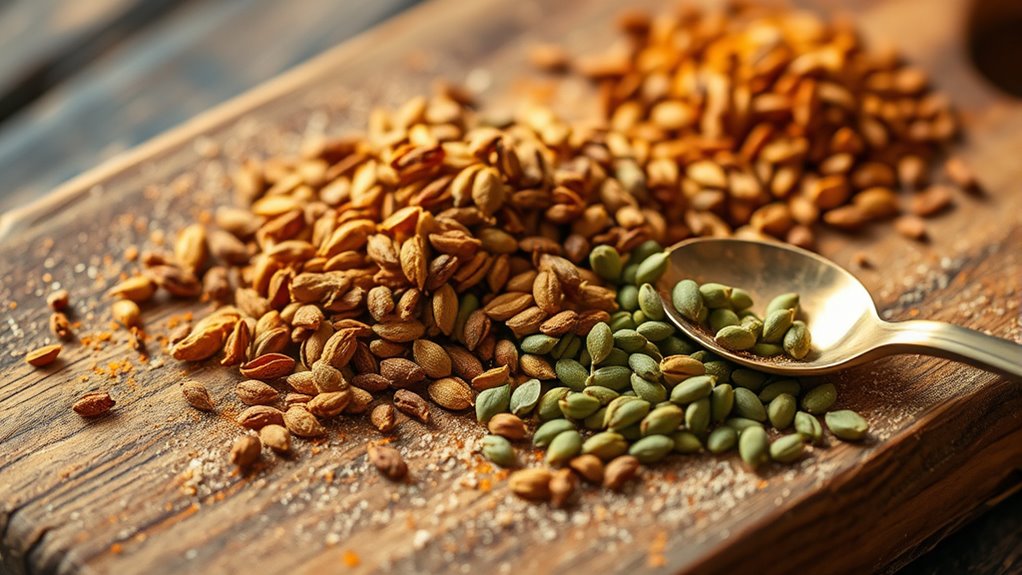
Cumin seeds and coriander are foundational to garam masala, bringing earthy, nutty, and citrusy notes that deepen the spice blend’s complexity. Cumin offers a warm, slightly bitter flavor that enhances heartier dishes, while coriander adds a bright, citrusy freshness that balances richness. Together, they create a harmonious base that elevates the aroma and taste of your cooking. Cumin’s deep, warm profile anchors the blend, making it versatile across various recipes. Coriander’s subtle brightness lifts the overall flavor, preventing the mix from becoming too heavy. Their combination provides a well-rounded foundation, allowing other spices like cardamom or cloves to shine without overpowering. Understanding their roles helps you appreciate how these seeds shape the distinctive character of garam masala. Incorporating low carb foods into your diet can complement the use of spices by adding nutritious, flavorful ingredients to your meals. Additionally, recognizing spice blend components can assist in customizing your own garam masala to suit personal taste preferences.
The Warmth of Cardamom and Cloves
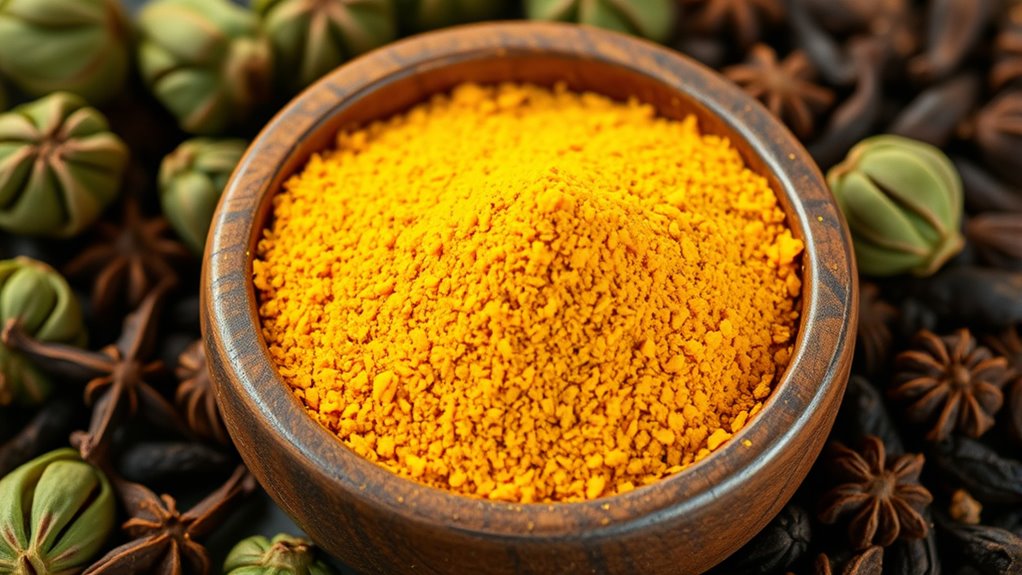
Cardamom and cloves bring a warm, aromatic depth to garam masala that elevates your dishes. Their flavor profiles not only enhance taste but also offer health benefits and versatile uses in cooking. Exploring their best culinary pairings can truly transform your culinary creations. Additionally, understanding the safety precautions associated with these spices can help you use them effectively and safely in your recipes. Recognizing the father-daughter bond can deepen your appreciation for the enduring connections that influence our daily lives. Being aware of potential adulteration is important to ensure you select high-quality spices for optimal flavor and safety. Incorporating proper storage techniques ensures the spices retain their flavor and potency over time. Developing leadership skills can also help in making informed decisions about choosing and handling spices in professional culinary settings.
Aromatic Flavor Profiles
Have you ever noticed how the warm, inviting aroma of garam masala instantly elevates a dish? That’s thanks to its aromatic flavor profiles, which add depth and complexity. You’ll detect a sweet, spicy scent from cardamom that feels both fresh and slightly citrusy. Cloves bring a rich, pungent aroma with hints of warmth and earthiness. Together, they create a fragrant symphony that awakens your senses. Imagine:
- The bright, floral notes of green cardamom pods
- The deep, spicy warmth of ground cloves
- A subtle sweetness lingering in the air
- An overall sense of cozy warmth that invites you in
These components balance each other, giving garam masala its signature aromatic allure that transforms simple ingredients into something extraordinary.
Health Benefits & Uses
Did you know that the warm, fragrant qualities of cardamom and cloves offer powerful health benefits? Cardamom aids digestion, relieves stomach discomfort, and may help lower blood pressure. Its antioxidant properties support overall health and improve oral hygiene. Recognizing patterns in recurring numbers can indicate spiritual messages, enhancing the ability to recognize these signs. Cloves contain eugenol, which has anti-inflammatory and antimicrobial effects, making them effective against bacteria and infections. Cloves also help alleviate toothaches and improve digestion. Both spices have been linked to blood sugar regulation and immune system support. You can incorporate them into your diet by adding crushed cloves to teas or using ground cardamom in baked goods. Besides flavoring foods, these spices can be used in teas, tinctures, or even as natural remedies for minor ailments. Their versatility in wellness routines makes them valuable additions to your health practices, especially considering their air purification benefits, which contribute to overall health. Additionally, their color-enhancing properties can improve the appearance of dishes and beverages, making them even more appealing. Recognizing spiritual messages from signs like angel numbers can enhance your awareness of these health and wellness cues.
Culinary Pairings
The warm, aromatic qualities of cardamom and cloves make them exceptional partners in the kitchen, elevating a wide range of dishes with their distinctive flavors. You’ll find them enhancing both sweet and savory creations, adding depth and complexity. Imagine fragrant rice pilafs where cardamom’s citrusy notes mingle with cloves’ spicy warmth. Or, consider spiced desserts like chai-flavored cakes, where these spices create comfort and richness. They also work beautifully in hearty stews, infusing meat and vegetables with aromatic layers. Additionally, you might sprinkle ground cloves over roasted vegetables for a smoky touch or brew cardamom with tea for a warming beverage. These spices can turn simple dishes into memorable, flavor-packed experiences. Understanding their regional origins can enrich your appreciation of these spices and inspire new culinary adventures, especially since their use varies across different cultural cuisines. Exploring the regional spice blends can further deepen your understanding of how these flavors are used globally, highlighting the importance of culinary traditions in shaping spice combinations. Incorporating spice pairing principles can help you create harmonious and balanced dishes that showcase the unique qualities of each component.
The Nutty Depth of Nutmeg and Mace

Nutmeg offers a warm, sweet aroma that enhances both sweet and savory dishes, while mace provides a more delicate, slightly peppery flavor. You’ll find that these spices add depth and complexity when paired with ingredients like meats, vegetables, or desserts. Understanding their unique profiles will help you use them effectively in your culinary creations. Exploring seasonal variations can also influence how these spices are best utilized in different recipes.
Nutmeg’s Aromatic Profile
Although often overshadowed by more prominent spices, nutmeg brings a complex, nutty depth to garam masala through its warm and aromatic profile. Its scent is inviting, blending sweetness with a hint of earthiness that enhances the overall spice blend. When you smell nutmeg, you notice a cozy warmth that evokes comfort and richness. Its aroma carries subtle notes of:
- Sweet, slightly fruity undertones
- Warm, spicy hints reminiscent of clove
- Earthy, woody nuances
- A touch of warmth that lingers on the senses
This aromatic profile adds depth and complexity, balancing out sharper spices and creating a harmonious flavor foundation for your dishes. Nutmeg’s scent invites curiosity and complements the vibrant, layered aromas characteristic of garam masala. Additionally, collagen and hyaluronic acid in eye patches can help improve skin elasticity and hydration, contributing to a more youthful eye area.
Mace’s Unique Flavor
Have you ever noticed how mace adds a distinct, nutty depth to garam masala that complements the warm spices? Unlike nutmeg, mace offers a slightly more delicate, yet complex flavor profile. Its aroma is warm, fragrant, and subtly sweet, with hints of citrus and earthiness. When you grind mace into your spice blend, it releases a richness that balances well with cinnamon, cardamom, and cloves. This nutty undertone enhances the overall warmth and depth of the mixture, making your dishes more aromatic and layered. Mace’s unique flavor elevates both savory and sweet recipes, adding a subtle complexity that sets garam masala apart. Its distinct profile guarantees that your spice mix remains vibrant, inviting, and memorable.
Culinary Uses and Pairings
The nutty depth of nutmeg and mace makes them versatile ingredients in both sweet and savory dishes. You can sprinkle a pinch on baked goods like cookies and pies, adding warmth and complexity. In savory meals, they enhance hearty stews, creamy sauces, and spice blends, giving depth and a hint of sweetness. Mace pairs beautifully with dishes featuring vegetables, meats, or rice, elevating their flavor profile. Nutmeg is perfect in beverages such as eggnog or mulled wine, imparting a cozy spice note. Both spices also work well in spice blends like garam masala or pumpkin spice, tying flavors together. Their aromatic qualities make them essential for creating memorable, well-rounded dishes that balance sweetness and earthiness.
Additional Spices That Enhance the Blend

Adding a few extra spices can elevate your garam masala blend, giving it a more complex and balanced flavor profile. Cardamom, cinnamon, and cloves are common additions that deepen warmth and sweetness. Nutmeg adds a subtle earthiness, while bay leaves can introduce a gentle aromatic note. Some cooks include dried chilies or black pepper for a spicy kick, enhancing heat without overpowering the mix. Fennel seeds contribute a sweet, licorice-like aroma, balancing the heat from other spices. These extras allow you to customize your blend to suit specific dishes or personal taste. Be mindful of quantities; start small and adjust as you go. Experimenting with these spices helps you craft a garam masala that’s uniquely yours, rich in depth and character.
The Process of Blending and Roasting Spices

To develop a rich and aromatic garam masala, you’ll want to carefully blend and roast your spices. First, combine your chosen spices in a dry skillet. As they heat, they release fragrant oils, transforming their aroma. You should:
- Gently toast cumin, coriander, and cardamom until they crackle and turn golden
- Shake the pan constantly to prevent burning and ensure even roasting
- Smell the spices as they release their aroma, indicating they’re ready
- Remove from heat and let cool before grinding
Roasting intensifies the flavors and creates a deeper, more complex profile. Once cooled, grind the spices into a fine powder. This process ensures your garam masala is vibrant, fresh, and full of layered aroma.
How Garam Masala Varies Across Regions
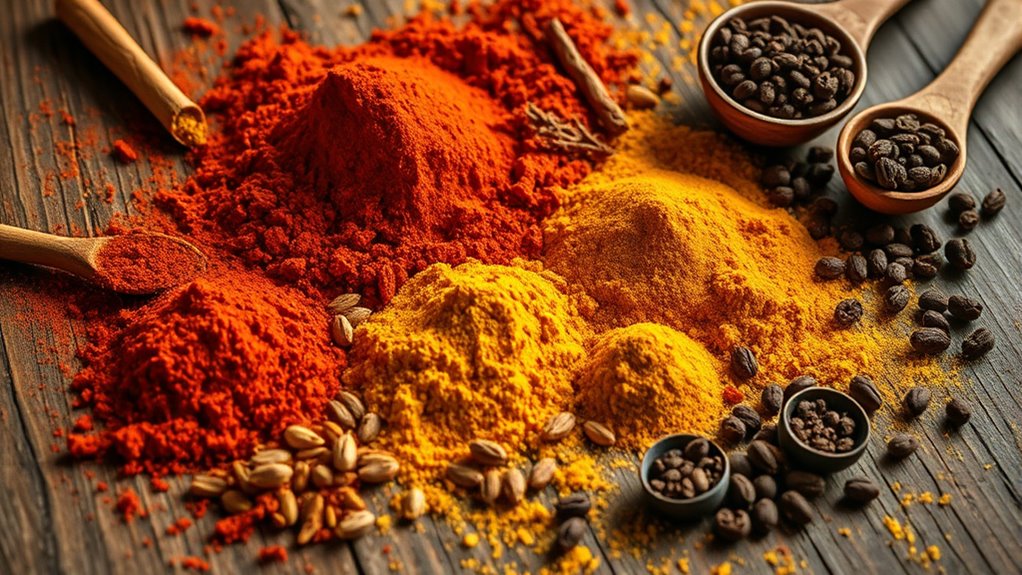
Garam masala varies widely across regions, reflecting local ingredients, culinary traditions, and cultural preferences. In North India, it often includes cinnamon, cloves, and black pepper, creating a warm, aromatic blend. South Indian versions might incorporate coriander and curry leaves, giving it a different flavor profile. In Pakistan, you might find a spicier mix with more cumin and cardamom, tailored for rich meat dishes. Nepalese blends emphasize unique ingredients like timur (Szechuan pepper) for a distinct heat. Meanwhile, in Bangladesh, garam masala may lean towards milder, sweeter notes. Regional differences also influence preparation methods and proportions, so your experience of garam masala can vary greatly depending on where it’s made. Understanding these variations helps you appreciate the rich diversity behind this essential spice mix.
Frequently Asked Questions
How Do Fresh Spices Differ From Dried in Garam Masala?
When you compare fresh spices to dried in garam masala, you’ll notice fresh ones have a more vibrant aroma and brighter flavor, while dried spices offer a concentrated, earthy richness. Fresh spices release essential oils quickly, giving your dish a lively punch, whereas dried spices provide depth and warmth over longer cooking. Using a mix of both can balance freshness with intensity, enhancing your spice blend wonderfully.
Can Garam Masala Be Customized for Dietary Restrictions?
Yes, you can customize garam masala for dietary restrictions. You might swap out ingredients, like using salt-free spices or allergen-free options, to suit your needs. For vegan or gluten-free diets, verify all components are plant-based and free from gluten. Experiment with ratios to match your preferences, and consider adding or removing spices to create a blend that fits your health requirements without sacrificing flavor.
What Are the Health Benefits Associated With Garam Masala Ingredients?
You might wonder about the health perks of garam masala ingredients. Each spice, like turmeric, cumin, and coriander, offers unique benefits. Turmeric contains curcumin, known for its anti-inflammatory and antioxidant properties. Cumin aids digestion and boosts immunity, while coriander supports digestion and has antimicrobial effects. Together, these ingredients can help reduce inflammation, improve digestion, and strengthen your immune system, making garam masala not just flavorful but also healthful.
How Long Does Homemade Garam Masala Stay Fresh?
You’ll want to use your homemade garam masala within about six months for peak flavor. Store it in an airtight container, kept away from direct sunlight and heat, to preserve its aroma and potency. Over time, the spices lose their freshness, so check for a dull aroma or flavor before using. For the best taste, grind fresh if possible, and replace the blend once it starts to fade.
Are There Any Common Substitutions for Traditional Spices in Garam Masala?
When traditional spices are hard to find, you might consider gentle replacements that bring familiar warmth. Cinnamon can be swapped with allspice or nutmeg, while cloves might be replaced with a pinch of star anise. Cumin and coriander can be substituted with caraway seeds or fennel. These tweaks help preserve the flavor’s richness without losing the essence, ensuring your dish stays vibrant and authentic.
Conclusion
Ever wonder if garam masala’s complex flavors come from a secret ancient recipe? While many believe it’s a timeless blend passed down through generations, recent studies suggest regional variations might actually be influenced by trade routes and local spice availability. So, next time you sprinkle garam masala, remember it’s more than just flavor — it’s a living history that evolves with each region’s unique spice story.
